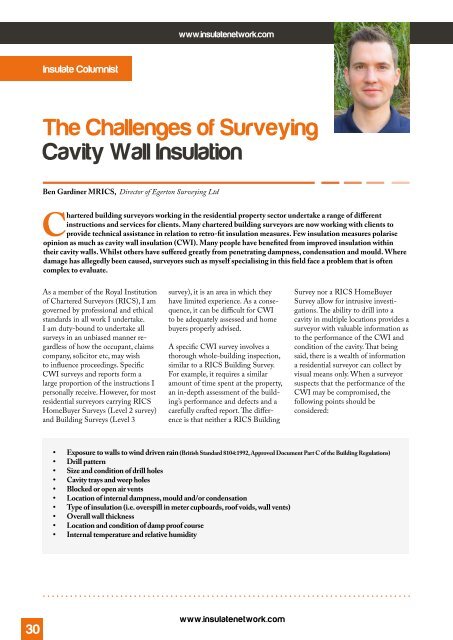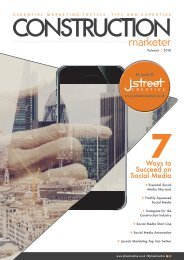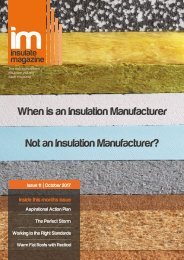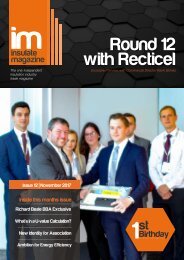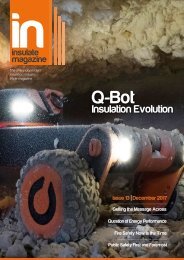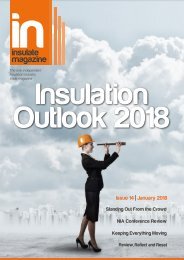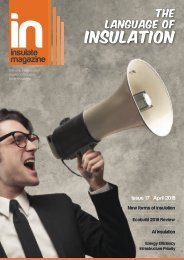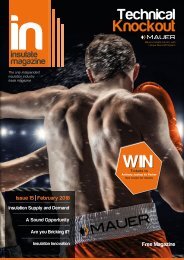Insulate - The Essential Insulation Magazine - May 2018
May Issue of Insulate Insulation Magazine: Exclusive in-depth interview with Isover Insulation's Huw Rees, Schooled in Insulation, Urgent action on Building Safety, Sound Methods of Construction. Also news from Kingspan Insulation, NIA, BUFCA, MIMA, IMA, 3M, Egerton, Baumit, Advanced Insulation, Knauf, Insulation Superstore and many more....
May Issue of Insulate Insulation Magazine: Exclusive in-depth interview with Isover Insulation's Huw Rees, Schooled in Insulation, Urgent action on Building Safety, Sound Methods of Construction. Also news from Kingspan Insulation, NIA, BUFCA, MIMA, IMA, 3M, Egerton, Baumit, Advanced Insulation, Knauf, Insulation Superstore and many more....
You also want an ePaper? Increase the reach of your titles
YUMPU automatically turns print PDFs into web optimized ePapers that Google loves.
www.insulatenetwork.com<br />
<strong>Insulate</strong> Columnist<br />
<strong>The</strong> Challenges of Surveying<br />
Cavity Wall <strong>Insulation</strong><br />
Ben Gardiner MRICS, Director of Egerton Surveying Ltd<br />
Chartered building surveyors working in the residential property sector undertake a range of different<br />
instructions and services for clients. Many chartered building surveyors are now working with clients to<br />
provide technical assistance in relation to retro-fit insulation measures. Few insulation measures polarise<br />
opinion as much as cavity wall insulation (CWI). Many people have benefited from improved insulation within<br />
their cavity walls. Whilst others have suffered greatly from penetrating dampness, condensation and mould. Where<br />
damage has allegedly been caused, surveyors such as myself specialising in this field face a problem that is often<br />
complex to evaluate.<br />
As a member of the Royal Institution<br />
of Chartered Surveyors (RICS), I am<br />
governed by professional and ethical<br />
standards in all work I undertake.<br />
I am duty-bound to undertake all<br />
surveys in an unbiased manner regardless<br />
of how the occupant, claims<br />
company, solicitor etc, may wish<br />
to influence proceedings. Specific<br />
CWI surveys and reports form a<br />
large proportion of the instructions I<br />
personally receive. However, for most<br />
residential surveyors carrying RICS<br />
HomeBuyer Surveys (Level 2 survey)<br />
and Building Surveys (Level 3<br />
survey), it is an area in which they<br />
have limited experience. As a consequence,<br />
it can be difficult for CWI<br />
to be adequately assessed and home<br />
buyers properly advised.<br />
A specific CWI survey involves a<br />
thorough whole-building inspection,<br />
similar to a RICS Building Survey.<br />
For example, it requires a similar<br />
amount of time spent at the property,<br />
an in-depth assessment of the building’s<br />
performance and defects and a<br />
carefully crafted report. <strong>The</strong> difference<br />
is that neither a RICS Building<br />
Survey nor a RICS HomeBuyer<br />
Survey allow for intrusive investigations.<br />
<strong>The</strong> ability to drill into a<br />
cavity in multiple locations provides a<br />
surveyor with valuable information as<br />
to the performance of the CWI and<br />
condition of the cavity. That being<br />
said, there is a wealth of information<br />
a residential surveyor can collect by<br />
visual means only. When a surveyor<br />
suspects that the performance of the<br />
CWI may be compromised, the<br />
following points should be<br />
considered:<br />
• Exposure to walls to wind driven rain (British Standard 8104:1992, Approved Document Part C of the Building Regulations)<br />
• Drill pattern<br />
• Size and condition of drill holes<br />
• Cavity trays and weep holes<br />
• Blocked or open air vents<br />
• Location of internal dampness, mould and/or condensation<br />
• Type of insulation (i.e. overspill in meter cupboards, roof voids, wall vents)<br />
• Overall wall thickness<br />
• Location and condition of damp proof course<br />
• Internal temperature and relative humidity<br />
30<br />
www.insulatenetwork.com


